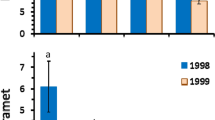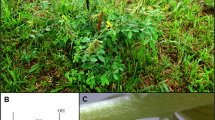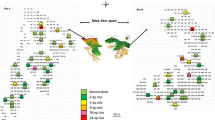Summary
The densities of four species of gall-forming sawflies were found to vary significantly among willow host plant clones. Two of the speices varied among host plants at four sites in each of three years. The other two species varied in density among host plants at most of the sites in two of the three years. Total sawfly density also varied significantly among clones. Individual species densities on willow clones were significantly positively correlated between years when all sites were combined and frequently when sites were considered separately. Most pairwise species combinations were independent in density between years, but some negative correlations existed between the stem galler and the leaf galler. Gall-former densities also were largely independent among clones within years with all sites combined and with sites considered separately. The significant correlations were nearly all positive. At all four sites the combination of significant variation in sawfly densities among willow clones in the field and independence of species densities among clones resulted in significantly different communities (relative abundance of species) among willow clones in three years. Although sawfly abundances differed substantially among the four sites, this remained true. It is argued that the pattern of community structure among clones is the result of variation in host plant quality of clones. We propose an hypothesis to account for patterns of herbivore species associations based on intrapopulation host plant variation.
Similar content being viewed by others
References
Clancy K, Price PW, Craig TP (1986) Life history and natural enemies of an undescribed sawfly near Pontania pacifica (Hymenoptera: Tenthredinidae) that forms leaf galls on Arroyo willow, Salix lasiolepis. Ann Entomol Soc Am 79:884–892
Craig TP, Price PW, Itami JK (1986) Resource regulation by a stem-galling sawfly on the arroyo willow. Ecology 67:419–425
Crawley MJ (1983) Herbivory: The dynamics of animal-plant interactions. University of California Press, Berkeley
Day PR (1974) Genetics of host-parasite interactions. Freeman, San Francisco
DaCosta CP, Jones CM (1971) Cucumber beetle resistance and mite susceptibility controlled by the bitter gene in Cucumis sativus L. Science 172:1145–1146
Edmunds GF Jr, Alstad DN (1978) Coevolution in insect herbivores and conifers. Science 199:941–945
Fritz RS, Sacchi CF, Price PW (1986) Competition versus host plant phenotype in species composition: willow sawflies. Ecology 67:1608–1618
Gallun RL, Starks KJ, Guthrie WD (1975) Plant resistance to insects attacking cereals. Ann Rev Entomol 20:337–357
Hare JD, Futuyma DJ (1978) Different effects of variation in Xanthium strumarium L. (Compositae) on two insect seed predators. Oecologia (Berlin) 37:109–112
James FC, Boecklen WJ (1984) Interspecific morphological relationships and the densities of birds. In: Strong DR Jr, Simberloff D, Abele LG, Thistle AB (eds) Ecological communities: Conceptual issues and the evidence. Princeton University Press, Princeton, NJ, USA, pp 458–477
Karban R (1986) Interspecific competition between folivorous insects on Erigeron glaucus. Ecology 67:1063–1072
Kareiva P (1982) Exclusion experiments and the competitive release of insects feeding on collards. Ecology 63:696–704
Kleinbaum DG, Kupper LL (1978) Applied regression analysis and other multivariable methods. Duxbury Press, North Scituate, MS, USA
Lawton JH, Hassell MP (1981) Asymmetrical competition in insects. Nature 289:793–795
Lawton JH, Hassell MP (1984) Interspecific competition in insects. In: Huffaker CB, Rabb RL (eds) Ecological entomology. Wiley, New York, pp 451–495
Lawton JH, Strong DR Jr (1981) Community patterns and competition in folivorous insects. Am Nat 118:317–338
Maxwell FG, Jennings PR (eds) (1979) Breeding plants resistant to insects. Wiley, New York
McDougall WB (1973) Seed plants of Northern Arizona. Museum of Northern Arizona, Flagstaff, Arizona
Moran N (1981) Intraspecific variability in herbivore performance and host quality: a field study of Uroleucon caligatum (Homoptera: Aphididae) and its Solidago hosts (Asteraceae). Ecol Entomol 6:301–306
Painter RH (1951) Insect resistance in crop plants. University of Kansas Press, Lawrence, Kansas, USA
Price PW (1983) Hypotheses on organization and evolution in herbivorous insect communities. In: Denno RF, McClure MS (eds) Variable plants and herbivores in natural and managed systems. Academic Press, New York, pp 559–596
Price PW, Craig TP (1984) Life history, phenology, and survivorship of stem-galling sawfly, Euura lasiolepis (Hymneoptera: Tenthredinidae), on the Arroyo Willow, Salix lasiolepis, in Northern Arizona. Ann Entomol Soc Am 77:712–719
Schluter D (1984) A variance test for detecting some species associations, with some example applications. Ecology 65:998–1005
Schoener TW (1986) Patterns in terrestrial vertebrate versus arthropod communities: do systematic differences in regularity exist? Community Ecology: Diamond J, Case TJ (eds). Harper and Row, New York, NY, USA, pp 556–586
Service PM (1984) Genotypic interactions in an aphid-host plant relationship: Uroleucon rudbeckiae and Rudbeckia laciniata. Oecologia (Berlin) 61:271–276
Service PM, Lenski RE (1982) Aphid genotypes, plant phenotypes, and genetic diversity: a demographic analysis of experimental data. Evolution 36:1276–1282
Siegel S (1956) Nonparametric statistics for the behavioral sciences. McGraw-Hill, New York
Smith EL (1970) Biosystematics and morphology of Symphyta. II. Biology of gall-making nematine sawflies in the California region. Ann Entomol Soc Am 63:36–51
Strong DJ Jr, Lawton JH, Southwood R (1984) Insects on plants: Community patterns and mechanisms. Blackwell, London, England
Wainhouse D, Howell RS (1983) Intraspecific variation in beech scale populations and in susceptibility of their host Fagus sylvatica. Ecol Entomol 8:351–359
Wiens JA (1984) On understanding a non-equilibrium world: Myth and reality in community patterns and processes. In: Strong DR Jr, Simberloff D, Abele LG, Thistle AB (eds) Ecological communities: Conceptual issues and the evidence. Princeton University Press, Princeton, New Jersey, USA, pp 439–457
Author information
Authors and Affiliations
Rights and permissions
About this article
Cite this article
Fritz, R.S., Gaud, W.S., Sacchi, C.F. et al. Variation in herbivore density among host plants and its consequences for community structure. Oecologia 72, 577–588 (1987). https://doi.org/10.1007/BF00378986
Received:
Issue Date:
DOI: https://doi.org/10.1007/BF00378986




